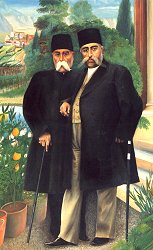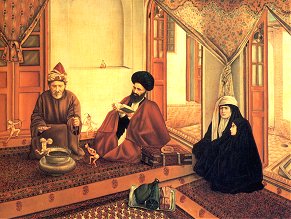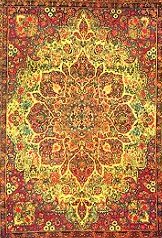|
|
|
|
Arts - Zand & Qajar Dynasties
The Qajar dynasty, which ruled Persia from 1794 to 1925, was not a direct continuation of the Safavid period. The invasion of the Ghilzai Afghan tribes with the occupation in 1722 of the Safavid capital Isfahan, and the eventual collapse of the Safavid Empire in the following decade plunged Iran into a period of political chaos. With the exception of the Zand interval (1750-79), the history of 18th century Iran was marred by tribal violence. This ended with the coronation of Agha Muhammad Khan Qajar in 1796, which ushered in a period of political stability that was characterised by a revival of cultural and artistic life.
The Zand and Qajar periods saw a continuation of oil painting introduced in the 17th century, and the decoration of lacquer boxes and book-bindings. Illustrated historical manuscripts and single page portraits were also produced for a range of patrons, in a style consistent with that of Muhammad Ali (son of Muhammad Zaman) and his contemporaries. While the excessive use of shading sometimes endows these works with a dusky quality, they do display an improved understanding of the play of light (coming from a single source) on three-dimensional forms.
The evolution of Persian art in the 18th and 19th centuries can be divided into distinct phases, beginning with the reign of Karim Khan Zand (1750-79), Fath Ali Shah (1797-1834) and Nasir ad-Din Shah(1848-96).
During the Zand period, Shiraz became not only the capital but also the centre of artistic excellence in Iran, and Karim Khan's building program in the city attempted to emulate Shah Abbas' Isfahan. Shiraz was endowed with fortifications, palaces, mosques and other civil amenities.
|
|
|
|
Karim Khan was also a noted patron to painting, and the Safavid-European tradition of monumental figure painting was revived under the Zand dynasty, as part of an overall revival of the arts.
|
Zand artists were as versatile as their predecessors. As well as developing life-sized paintings (murals and oils on canvas), manuscripts, illustrations, watercolours, lacquer work, and enamels from the Saffavid dynasty, they added a new medium that of wash drawing. However, in their paintings, the results often appeared to be rigid, since the Zand artists in order to correct what they considered an excessive emphasis on three-dimensionality, attempted to lighten the composition by the introduction of decorative elements. Sometimes pearls and various jewels were painted on the headgear and clothing of the subjects. |
|
|
|
Karim Khan, who preferred the title Regent (Vakil) to that of Shah, did not demand that his painters prettify his appearance; he was happy to be shown at an informal and unpretentious gathering in a modest architectural setting. The tone of these Zand paintings contrast sharply with the later images of Fath Ali Shah (the second of the seven rulers of the Qajar dynasty) and his court. There is an unquestionable Zand inheritance in early Qajar art. It is known that the founder of the Qajar dynasty, Agha Muhammad Khan, decorated his Tehran audience hall with paintings looted from the Zand palace and Mirza Baba (one of Karim Khan's court artists) went on to become Fath 'Ali Shah's first painter-laureate. |
Fath Ali Shah was particularly receptive to ancient Iranian influences, and numerous rock relieves were carved in neo-Sassanian style, depicting the Qajar sovereign in the guise of Khosroe.
|
The best known reliefs are at Chashma-i-Ali, at Taq-i-Bustan, and in the vicinity of the Koran Gate in Shiraz. Under Fath Ali Shah there was a clear return to tradition; however, at the same time late 18th century European court style appeared in the palaces in Tehran. European influences also mingle with Sassanian and neo-Achaemenid themes in the carved figural stucco of this period (as can be seen in many houses in Kashan). |
|
Fath Ali Shah also used large-scale frescoes and canvasses to create an imperial personal image. Portraits of princes and historical scenes were used to adorn his new palaces and they were often shaped like an arch in order to fit into a space in the same shape on a wall. Fath Ali Shah also distributed several paintings to foreign powers such as Russia, Britain, France and the Austro-Hungarian Empire.
|
|
<
Portrait
of Fath 'Ali Shah seated, by Mihr 'Ali c. 1813-14 from The State Hermitage Museum Saint Petersburg.
|
|
The interaction of popular style and European influence is even more evident in painting, with Flemish and Florentine elements appearing in the painting of the dancer "Mazda" by Madhi Shirazi (1819-20). With the introduction of printing and large scale painting some of the finest Qajar miniature artists turned their hand to lacquer work such as book bindings, caskets, and pen boxes (qalamdan). The style is in particular cosmopolitan and characteristic of a court that attempted to combine the styles of Persepolis, Isfahan and Versailles. |
|
In the second half of the 19th century Nasir al Din Shah, as well as collecting European artworks supported a local school of portraiture which abandoned the style of Fath Ali Shah in favour of a European-influenced academic style. The works of these local artists ranged from state oil portraits to watercolours of unprecedented naturalism. Photography now began to have a profound impact on the development of Persian paintings. Soon after it was introduced into Iran in the 1840s, Iranians promptly adopted the technology. Nasir-al Din Shah's Minister of Publication, I'timad al-Saltaneh, claimed that photography had greatly served the art of portraiture and landscape by reinforcing the use of light and shade, accurate proportions and perspective. |
|
|
|

|
|
In 1896 Nasir al-Din Shah was assassinated and within ten years Iran had its first constitutional parliament. This period of political and social change saw artists exploring new concepts, both within and beyond the confines of imperial portraiture.
 "Exorcist and clients" By Kamal al-Mulk, or his circle. Tehran c. 1900 In contrast to earlier paintings of Royalty and nobility, this picture shows a move towards the portrayal of common people in the early 20th century. |
In the double portraiture of Muzaffar al-Din Shah the prematurely aged ruler is shown resting one arm on a cane, the other on the supporting arm of his Premier. The artist here conveys both the frail health of the Monarch and the Monarchy. The most important artist of the late Qajar period was Muhammad Ghaffari, known as Kamal al-Mulk (1852-1940) who championed a new naturalistic style. Qajar tile-work is usually unmistakable. The repertory of the so-called cuerda seca tiles shows a completely new departure from that of the Safavid period. For the first time representations of people and animals form the main subject matter; there are hunting scenes, illustrations from the battles of Rostam (the hero of the national epic, Shah-nama) soldiers, officials, scenes of contemporary life and even copies of European illustrations and photographs. |
The Qajar technique par excellence - again triggered by European influence, in this case Venetian glass- was mirror-work. Mugarnes cells faced with mirrors yielded an original and spectacular effect, as can be seen in the Golestan palace in Tehran or the Hall of Mirrors in Mashad's Holy Shrine.
|
|
|
In the field of applied arts, only weaving continued to have an importance that extended beyond the borders of Iran, and during the Qajar period, the carpet industry gradually revived on a larger scale.
|
|
|
Although many traditional designs were retained, they were expressed in different ways, often smaller in scale than their Safavid prototypes, with the use of a brighter range of colours.

Details of a magnificent 19th
century Kerman Ravar carpet